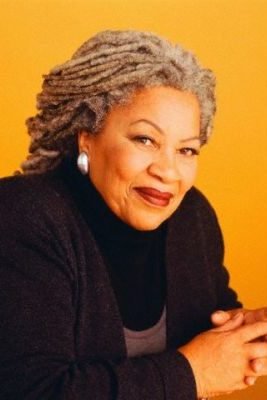Black History Month Celebration: Deei’s Book Review of “Beloved” by Toni Morrison
Beloved
By Toni Morrison
This book was the first horror book I chose for myself by an African American woman. I came across it by chance though and it became one of my favorite ghost stories. My high school was not very well ranked but one thing I loved about it was students were allowed to take any copies of overstocked books home for free. I was glancing through the pile when a book with carmine cover and a single word in manila colored script caught my eye. The title, Beloved further captured my interest.
After confirming this book was available, I took it home and it sat on my shelf until the school year ended. Once I started it though, sitting in the shade outside, I could not put it down. The first two opening sentences ensnared me completely.
124 was spiteful. Full of a baby's venom.
The word, spiteful, in particular caught me. It was so specific and a word I’d rarely associated with a baby, which are nearly universally considered innocent and incapable of an emotion so complex as spite.
That seemed to be one of Morrison’s many gifts. She chose when to specifically describe something with exquisite metaphors or brutal honesty. But she also knew when to let the reader’s imagination do the work for her.
Something like that had happened to Ella except it was two men—a father and son—and Ella remembered every bit of it. For more than a year, they kept her locked in a room for themselves. “You couldn’t think up,” Ella had said, “what them two done to me.”
Beloved follows the story of Sethe, who escaped to Ohio from slavery at Sweet Home. Heavily pregnant with her soon-to-be daughter, Denver, she makes her way North to live with her Mother-in-Law Baby Suggs, who had been freed by her son and Sethe’s husband, Halle, and their other children. When slavecatchers come for Sethe, she makes a decision to murder her children and then commit suicide before being taken back. She only succeeds in murdering her eldest daughter, who was never given a name, her tombstone only carrying the word “Beloved”. This action leads to many of the supernatural events that occur during the story, which flits between several time periods.
The characters are rich and the story flits between dark imagery, detailing the grim lives of the slaves to the newly freed regaining their own bodies. Another character from Sweet Home, Paul D., describes the horrors of working on a chain gang in Georgia. His experiences prior and during this time cause him to lock away his heart, protecting it from others in a rusted tin. One thing I always worry when reading stories like this is the constant misery and lack of any joy or hope. Beloved is very bleak but there are also moments of peace, happiness, and potential acceptance for the characters. During a sermon given by Baby Suggs, she urges the listeners to take joy in their bodies and learn to love themselves since everyone else longs to abuse and break them.
She did not tell them to clean up their lives or to go and sin no more. She did not tell them they were the blessed of the earth, its inheriting meek or its glorybound pure. She told them that the only grace they could have was the grace they could imagine. That if they could not see it, they would not have it. “Here,” she said, “in this here place, we flesh; flesh that weeps, laughs; flesh that dances on bare feet in grass. Love it. Love it hard. Yonder they do not love your flesh. They despise it.”
I was immediately fascinated by the entire story, slowly taking me on this journey with these amazing characters. I was drawn to both Sethe and Denver. These two women were undergoing unique circumstances wildly different than my own, but I could relate to my own mother and my relationship at times. Sethe is a protagonist who takes determination to the dark places that many of us could not even imagine. Even if Morrison had not written passages showing the cruelty and dehumanization that occurred to Sethe and the other slaves at Sweet Home, her actions to her daughter, the crawling-already baby girl, would. To protect her children from being captured and forced into slavery, she would rather kill them herself.
The first time I read this scene, it brought me back to events that took place in my own childhood. My family is very religious and at several points in my youth, my parents told me they would let me die before denying their faith. As an adult I can rationalize that they may have had a change of heart if brought to this choice in anything other than a thought experiment, but as a child, part of me hated them for it. I can also now feel empathy towards Sethe and admit she had a justifiable reason for her actions. However, as a teen girl I felt as spiteful as 124 towards her. This was so unjust but due to my own past, I could not judge her fairly. When Beloved, whose actual identity is unclear, appears, I felt a vindictive pleasure in seeing Sethe spend all her time doting on the young woman to the point of neglecting her own health and nearly dying.
When I reread the book a year or two later, my opinion of Sethe was much kinder. The things she had to endure were beyond the scope of most human’s understanding. Sethe’s own mother struck her for requesting a mark, something to consider her property. Stamp Paid’s story to Paul D. also made more sense to me. At this point, I had seen people lash out at loved ones in to protect them from danger in the world. I’d also lashed out at loved ones because I could not react when treated cruelly by people in power over me. I am aware that my power dynamic was also nowhere near as disparate as it was for people like Sethe or Stamp Paid. I cannot begin to fathom the anguish.
Since Beloved, I have read many more books by both African and African American men and women. The tragedy of this ghost story haunts me frequently and I revisit the novel quite often. I’m pleased I found Morrison’s works early enough to pique my interest in the amazing stories from this community. I find the stories include joy, horror, beauty, rage, and teach me more about so many types of people. When an author can make me emphasize so strongly with their characters, they have done a great job with their craft.
Review by Dee
Twitter @Sirenofscience





